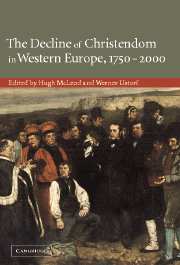Book contents
- Frontmatter
- Contents
- List of contributors
- Preface
- 1 Introduction
- Part I
- 2 The secularisation decade: what the 1960s have done to the study of religious history
- 3 Christendom in decline: the Swedish case
- 4 New Christianity, indifference and diffused spirituality
- Part II
- Part III
- Part IV
- Index of people and places
- Subject index
4 - New Christianity, indifference and diffused spirituality
Published online by Cambridge University Press: 03 July 2009
- Frontmatter
- Contents
- List of contributors
- Preface
- 1 Introduction
- Part I
- 2 The secularisation decade: what the 1960s have done to the study of religious history
- 3 Christendom in decline: the Swedish case
- 4 New Christianity, indifference and diffused spirituality
- Part II
- Part III
- Part IV
- Index of people and places
- Subject index
Summary
When theories of secularisation came to the forefront in the 1960s and 1970s, western religious evolution appeared to be The Decline of the Sacred in Industrial Society, especially in Europe. It is well known that the last thirty years have further complicated this pattern. We have witnessed the rise of the NRMs (New Religious Movements), the expansion of Pentecostal, Evangelical and Charismatic tendencies (throughout Christianity), the worldwide success of Pope John Paul II, the diffusion of parallel beliefs (astrology, telepathy, near death experiences, and so on), the development of religious fundamentalism, although essentially in the non-western world (especially the Islamic countries), and the collapse of communism in eastern Europe. Now we speak of desecularisation and the recomposition of religion. Meanwhile, in western Europe, the erosion of religious belonging paradoxically continues and the secularisation thesis remains the only master narrative, as Jeffrey Cox observes. But how can we explain both of these tendencies?
From the beginning of modernity until now, we can in fact observe five principal trends at work in current western religious evolutions: the development of secular systems, religious decline, transformations/revivals of Christianity, traditionalist-fundamentalist reactions, and innovations, especially new religious forms (NRMs, para-scientific beliefs, self-spirituality). Lester Kurtz refers to: (1) the substitution of religious traditions by rationalism, scientism and individualism; (2) secularisation; (3) the revitalisation of traditional forms; (4) the construction of quasi-religious forms, such as civil religion or ideologies (the latter I personally consider as secular forms); (5) the creation of new forms of religious beliefs and practices.
- Type
- Chapter
- Information
- The Decline of Christendom in Western Europe, 1750–2000 , pp. 63 - 78Publisher: Cambridge University PressPrint publication year: 2003
- 19
- Cited by



